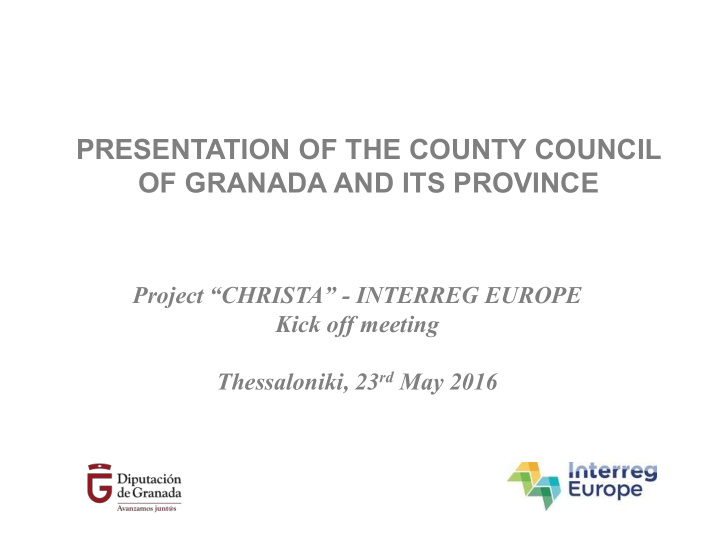



PRESENTATION OF THE COUNTY COUNCIL OF GRANADA AND ITS PROVINCE Project “CHRISTA” - INTERREG EUROPE Kick off meeting Thessaloniki, 23 rd May 2016
The County Council of Granada Local Government of the Province of Granada (Andalusia, Spain) that represents and renders services to 172 municipalities that are part of the Province. Local Public Administration with his own competencies and competencies delegated by the Regional Government. Own competencies: Coordinating municipal services Legal, economic and technical assistance to town councils, especially to those who have less economic and management capacities Rendering public services with a supramunicipal or local nature Encouraging and managing particular interests of the Province
The County Council of Granada The County Council works in cooperation with municipalities of the Province of Granada and their associations. It is mainly made in the framework of an agreement procedure through which services rendered to municipalities are formally agreed between both organisations. It also closely collaborates with social agents , NGO, enterprises… through several kinds of agreements, networking and projects. Its staff is around 1.732 people.
DELEGATION OF EMPLOYMENT AND SUSTAINABLE DEVELOPMENT Department devoted to promote local development of municipalities and the Province as a whole, founded in 1993 Main lines of the work program are: 1) Office of European Projects for Provincial Development 2) Self-employment and business consolidation 3) Training for Employment 5) Encouragement of Rural Development
INTRODUCTION TO THE PROVINCE OF GRANADA The Province is in the South East part of Spain and belongs to the Andalusia Region G ranada
INTRODUCTION TO THE PROVINCE OF GRANADA Population and territory Territory : 12.647 square kilometres, 14,43 % of Andalusia and 2, 7 % of Spain. Great territorial imbalances Geographical diversity Rural character Population : 919.455 inhabitants (2014), 10,94% of Andalusia Population very unequally distributed Progressive ageing of population
INTRODUCTION TO THE PROVINCE OF GRANADA ECONOMY : Main characteristics Lack of entrepreneurial initiatives High concentration of activity in the main city Metropolitan Area High importance of Tertiary Sector : trade and public services Dependence on building activity Important role of agrarian sector Weakness of industry Great importance of informal economy Predominance of micro-enterprises a nd self-employed High unemployment rate: 35,1% (2014)
PROFILE OF THE PROVINCE OF GRANADA AS TOURIST DESTINATION General observations We have many and diverse resources as cultural and natural landscapes as a result of a strong geographical contrast : from the highest peak of the Iberian Peninsula to a subtropical coast. The biggest part of the territory has a rural character An important surface of our province is inside of a protected natural area The territory has a very long history that has left municipalities plenty of monuments , peculiar architecture and ethnographic heritage . Main city of the province is full of monuments that makes it one of the main Spanish tourist attractions The province has several minor historical centres whit great tourist exploitation possibilities
PROFILE OF THE PROVINCE OF GRANADA AS DESTINATION Number of visitors / year in the Province of Granada 2.528.744 visitors made use of hotels of the Province (2014) This number grows every year Main attractions : City of Granada (Alhambra Palace is the most visited monuments of Spain) Tropical Coast Sierra Nevada sky resort: highest pick of the Iberian Peninsula Different areas with rural character: o Alpujarra, candidate to be a World Heritage Site o Several areas with cave-dwelling lodgements o Natural / cultural landscapes oTourism associated to palaeontology or archaeology o Etc. Troglodyte houses
PROFILE OF THE PROVINCE OF GRANADA AS DESTINATION Types of tourism Several forms of rural tourism: Cultural: physical and ethnographic culture Tourism linked to landscape and mountains, active and sport tourism included Coastal tourism An important sky resort (the biggest peak of the Iberian Peninsula is in our Province. Urban tourism: Granada city, with great importance because of its monuments, history, university. The tourist attraction of the city is undeniable But the province is also plenty of minor historical centres with great tourist potential
PREVIOUS EXPERIENCES IN EUROPEAN PROJECTS Long and diverse experience in designing and implementing Structural Funds projects, many of them in the framework of interregional cooperation Period 2007-2013: 31 projects – Management of 49.559.662,26 € – EU Funds received 21.319.886,18 € Period 2000 – 2006: 21 projects – 30.313.490,21 € managed – EU Funds received 2.982.391,21 € Participation in most of European Programmes : different editions of INTERREG, Cross Border Cooperation Programmes, MED, SUDOE, Local and Urban Development of ERDF, Innovative Actions ESF, Leonardo, Youth in Action, Intelligent Energy Europe, Europe for Citizens, Culture, INTERACT, EQUAL, URBAL, O.P. Adaptability EFS, etc.
PREVIOUS EXPERIENCES IN EUROPEAN PROJECTS Some projects connected to CHRISTA subject: TOURAGE: senior tourism as a tool for development of rural areas (INTERREG IV C) CesR: mutualisation of jobs around tourism sector in rural areas (INTERREG IV C) “CULTURMED”: Promote natural and cultural heritage of Alpujarra area to support its declaration as World Heritage site (Cross-border cooperation Spain-Morocco) “ETNOMED”: Increase the potential of common ethnographic heritage in the province of Granada and Northern Morocco (Cross-border cooperation Spain-Morocco) “ECEMED”: Integrated, sustainable development around medium -sized cities. It includes several measures linked to tourism (Local and Urban Development – ERFD)
PREVIOUS EXPERIENCES IN EUROPEAN PROJECTS Some projects connected to CHRISTA subject: “TEMA": Integrated, sustainable development around mountainous areas. It includes several measures linked to tourism (Local and Urban Development – ERFD) “MAGREC”: Revitalisation of historical heritage and local identity in Granada and Northern Morocco (Cross-border cooperation Spain-Morocco) “Network of Minor Historical Centres”: Cultural, touristic and natural raise in value of minor historical centres. (INTERREG III B MEDOCC) “EUROCAVES”: Raise in value of troglodyte heritage (INTERREG III C)
THANK YOU FOR YOUR ATTENTION
Recommend
More recommend